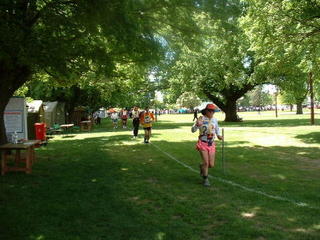
by George Audley
Hi All
The day after my 406 kilometre (251 miles) run and I have decided not to go
out for a jog for a couple of days.
My run started on my birthday at 10 am and the only one to see me off was
Christine. 8 hours later just before it go dark at 6 pm we pulled in for the
night with 55 k's (35 miles completed) Every 5 k's (3 miles) Christine had
waited for me with food and drink so she was also ready for a break. The
Camper was ideal.
Each day it was on the road for 6 am with a reflector vest on till it got
light. The 2nd, 3rd, 4th, and 5th days were the same 75 k's (47 miles) run
This was broken up into 4 runs split by 3 x 30 minute breaks for meals and
rest, finishing just before 6 pm. The last night we finished at a service
station who served a lovely Fisherman's Basket. The last day was the
shortest with only 50 k's (31 miles). I think I ran too hard with Albany so
near and my knee started to trouble me, but nothing was going to stop me
that close to home. The TV came out to meet me along the road and that
picked me up and I cruised the last bit doing a bit of walking to make sure
I finished at the time I had said which was 2 pm.
The run was undulating with a constant headwind Main problem was the passing
road trains that almost pushed me backward but only got my hat once (Duck
your head or lose your hat) At about the halfway mark the rains came so I
had a backpack on with my rain jacket in because Christine could be a long
way off. All in all it was a great birthday present from Christine
A good training run for the Colac 6 Day Race in November
George
